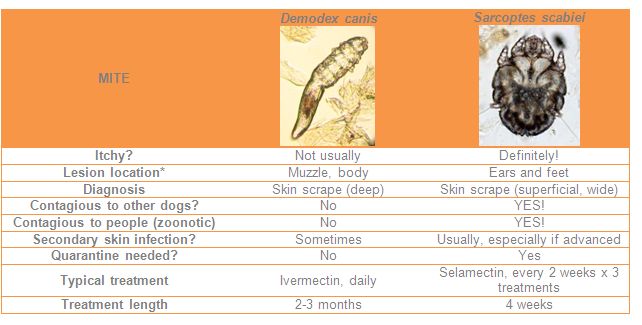What is Mange, Anyway?

By Erica Smedberg, DVM, shelter veterinarian at Dane County Humane Society
There are two main types of mange in dogs- demodectic mange, caused by the mite Demodex canis and sarcoptic mange, caused by the mite Sarcoptes scabiei.
Although many people refer to dogs affected with either one of these mites as having “mange”- it is imperative that we determine which type of mite the dog has in order to provide proper treatment. If you remember nothing else- remember this:
- Demodex is considered “normal flora” and is not contagious to other animals or people.
- Sarcoptes is a zoonotic disease- it causes “scabies” in humans and is contagious to other animals.
Sarcoptes mites can only live off the host for a few hours to a few days at most; they live longer in cool and humid environments. This means that your quarantine and isolation protocols do not need to be as strict. You should be able to safely release most quarantine restrictions from a Sarcoptes-infected dog 2 weeks after the first treatment. Most parasitologists believe that these dogs are no longer contagious 5-7 days after treatment but in a shelter environment it is best to “play it safe” and wait until the second treatment is given.
Demodex usually only causes skin disease when the dog is immunosuppressed for some reason. Puppies are most commonly affected. Localized demodex may resolve on its own without treatment but the pros and cons of this approach should be discussed with your shelter’s veterinarian.
* Please remember, only a licensed veterinarian can make diagnoses and prescribe treatment.
Knowing what mite you are dealing with is critical to protecting the rest of your shelter animals and staff. Use the handy chart below to learn more about the differences between Demodex and Sarcoptes!
There are two main types of mange in dogs- demodectic mange, caused by the mite Demodex canis and sarcoptic mange, caused by the mite Sarcoptes scabiei.
Although many people refer to dogs affected with either one of these mites as having “mange”- it is imperative that we determine which type of mite the dog has in order to provide proper treatment. If you remember nothing else- remember this:
- Demodex is considered “normal flora” and is not contagious to other animals or people.
- Sarcoptes is a zoonotic disease- it causes “scabies” in humans and is contagious to other animals.
Sarcoptes mites can only live off the host for a few hours to a few days at most; they live longer in cool and humid environments. This means that your quarantine and isolation protocols do not need to be as strict. You should be able to safely release most quarantine restrictions from a Sarcoptes-infected dog 2 weeks after the first treatment. Most parasitologists believe that these dogs are no longer contagious 5-7 days after treatment but in a shelter environment it is best to “play it safe” and wait until the second treatment is given.
Demodex usually only causes skin disease when the dog is immunosuppressed for some reason. Puppies are most commonly affected. Localized demodex may resolve on its own without treatment but the pros and cons of this approach should be discussed with your shelter’s veterinarian.
* Please remember, only a licensed veterinarian can make diagnoses and prescribe treatment.
Knowing what mite you are dealing with is critical to protecting the rest of your shelter animals and staff. Use the handy chart below to learn more about the differences between Demodex and Sarcoptes!
* Lesion location can vary but these are the typical sites

